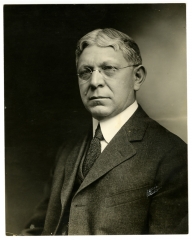M. Williams, ’95, President of the Alumni Corporation, and Bernard P. Taylor, ’24, Secretary, and its effectiveness assured its perpetuation by each successive senior class. The commencement of 1940 was made notable by granting an honorary degree to Mrs. Frances Payne Bolton, Member of Congress and the great-granddaughter of Elisha Payne, one of Colgate’s “Thirteen Men.”
As the expanding Alumni Corporation came to play an increasingly greater part in University life, a full-time secretary became necessary.Raymond E. Brooks, ’06, one of the organization’s founders, was appointed in 1925 to relieve Professor Alton, who had combined responsibilities for alumni affairs with his many other duties, and was assigned office space in the Administration Building. His successors were: Bernard P. Taylor, ’24 (1929-35), Herschel L. Mosier, ’22 (1935-42), and Carlton O. Miller, ’14 (1942-60); the latter had also been one of those who had established the corporation in 1919.
The program for alumni activities included the annual Homecoming Day, first held in the fall of 1923 to give the graduates an opportunity to see the college “in its shirtsleeves” since the usual day-to-day operations were suspended when they came in June. With the conclusion of the Million Dollar Campaign, the first of the annual alumni funds was established in 1925 to be completed the following spring. As a means of building alumni loyalty and interesting prospective freshmen in Colgate, the corporation in 1926 and 1940 sponsored the production of films which presented various characteristic features of undergraduate life in and out of the classroom and which had extensive showings before alumni groups and in secondary schools. Student selection was a service to the University which appealed to many alumni and under the leadership of George W. Cobb, ’94, committees for this purpose were formed throughout the country and sent many fine young men to Colgate. Undergraduates were also enlisted in this enterprise and prizes were given for those who were particularly diligent in the work. To honor those men who made outstanding contributions, the Alumni Corporation in 1937 instituted Alumni Awards for Distinguished Service; the first recipients were most fittingly James C. Colgate and George W. Cobb.
As Dr. Cutten’s administration drew to a close with his resignation to take effect in the summer of 1942, World War II had already changed the aims and operation of the University and further and more





